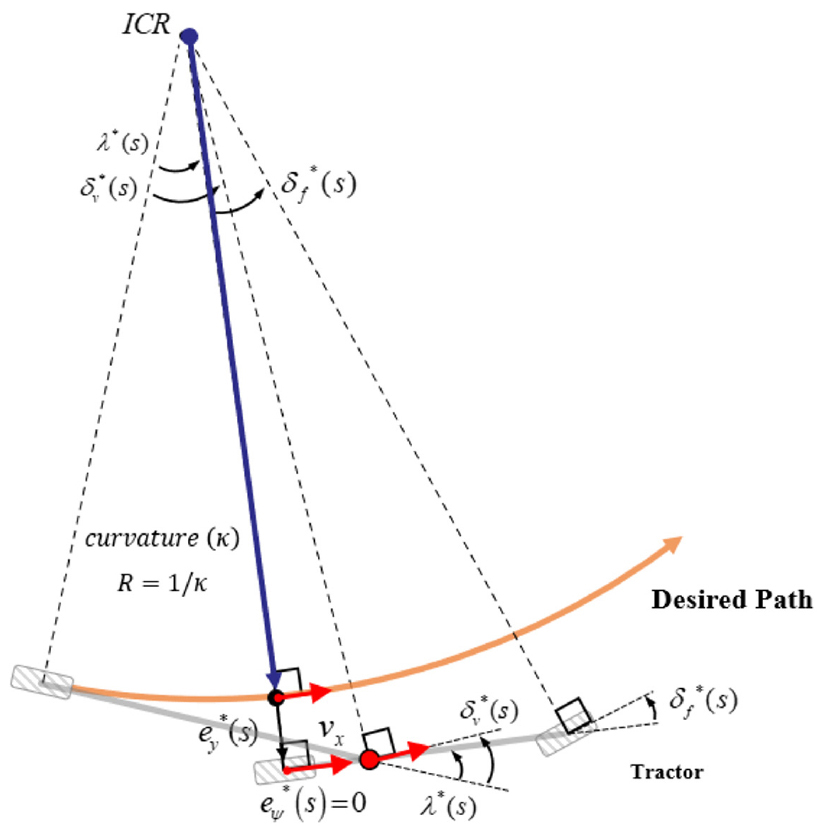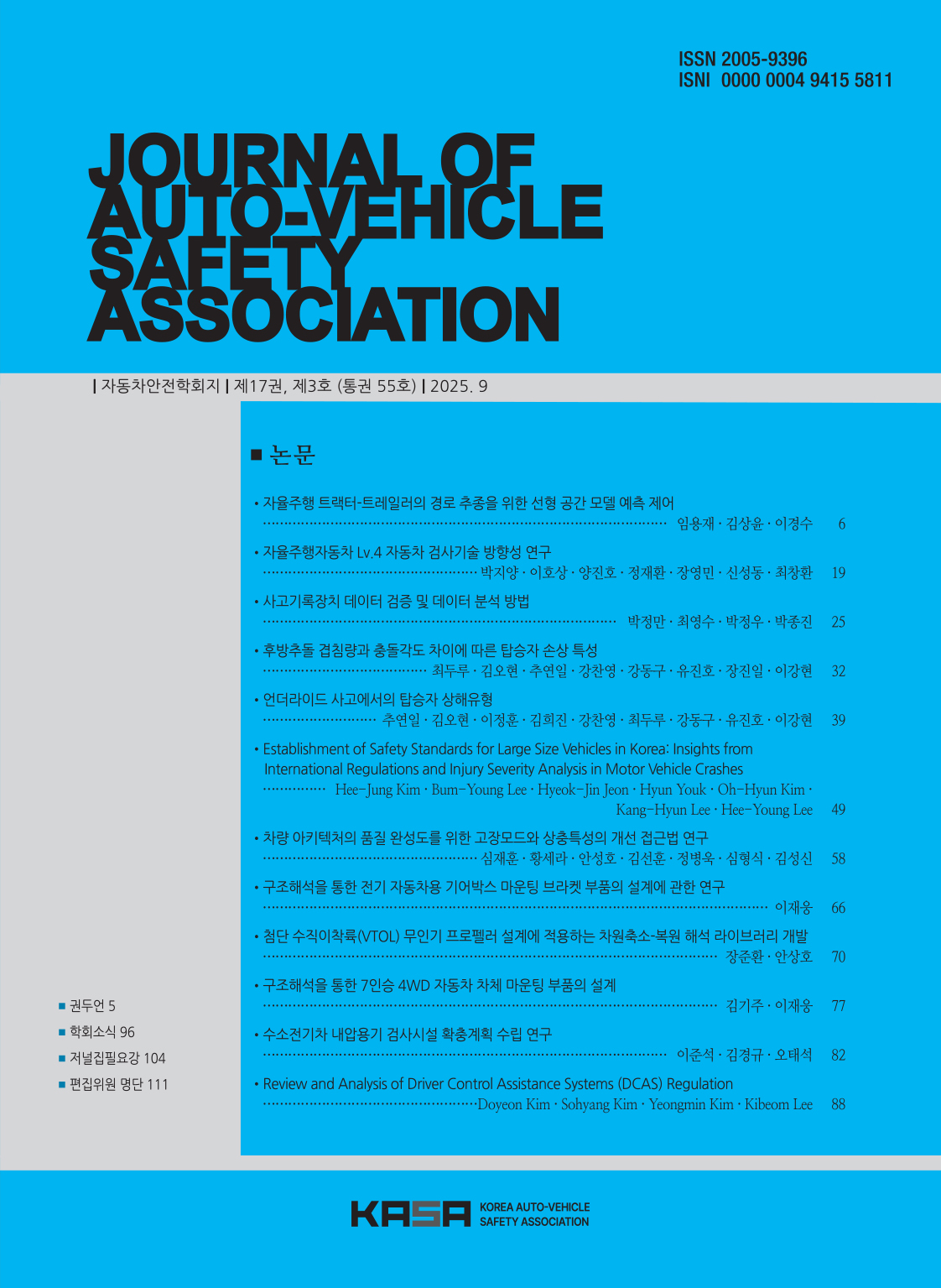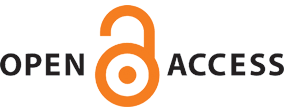-

-
Tractor-Trailer Steering Control for Path Tracking with Linear Spatial Model Predictive Control
자율주행 트랙터-트레일러의 경로 추종을 위한 선형 공간 모델 예측 제어
-
Yongjae Lim, Sangyoon Kim, Kyongsu Yi
임용재, 김상윤, 이경수
- In the realm of tractor-trailer control, the Nonlinear Model Predictive Controller (NMPC) has demonstrated superior performance in tackling complex driving scenarios. However, …
- In the realm of tractor-trailer control, the Nonlinear Model Predictive Controller (NMPC) has demonstrated superior performance in tackling complex driving scenarios. However, it comes with a substantial calculation time burden. This paper introduces a Linear Spatial Model Predictive Control (LSMPC) designed to reduce runtime while ensuring performance. Our focus lies on steering control to position the rear wheels of tractor and trailer along the desired path. LSMPC is implemented by CVXGEN. For verifying our controller, we use TruckSim simulation environment and compare LSMPC and Nonlinear Spatial Model Predictive Control (NSMPC). Our findings indicate that while LSMPC maintains lateral error within allowable range considering road lane width, it excels NSMPC in convergence speed due to its reduced runtime. - COLLAPSE
-
Tractor-Trailer Steering Control for Path Tracking with Linear Spatial Model Predictive Control
-

-
Research on the Direction of Inspection Technology for Autonomous Vehicles Level 4
자율주행자동차 Lv.4 자동차 검사기술 방향성 연구
-
Jiyang Park, Hosang Lee, Jinho Yang, Jaehwan Jeong, Youngmin Jang, Seongdong Shin, Changhwan Choi
박지양, 이호상, 양진호, 정재환, 장영민, 신성동, 최창환
- Efforts are being made worldwide to usher in the era of autonomous driving. According to an IEEE report, it is expected that …
- Efforts are being made worldwide to usher in the era of autonomous driving. According to an IEEE report, it is expected that by 2040, approximately 75% of vehicles worldwide will have transitioned to autonomous Vehicle. Looking at the actual stages of autonomous driving, SAE Level 4 autonomous vehicles are expected to bring about a paradigm shift in the future automotive market, operating at a level where driver intervention is not necessary, with the system performing core driving control, monitoring the driving environment, and handling emergencies, although the system does not always have complete control. Accordingly, in the case of the automobile inspection business, which is one of the major businesses conducted by the Korea. Level 4 autonomous vehicles may not have drivers, so the existing inspection methods have limitations. therefore, based on various standards and current research conducted by the KAVIC(Korea Advanced Vehicle Inspection R&D Center), I intend to propose the direction of Level 4 Autonomous Vehicle inspection technology. This Study aims to understand the trends of autonomous vehicles both domestically and internationally, and to analyze the current safety standards for Level 3 autonomous vehicles accordingly. Furthermore, we aim to introduce the developed inspection technologies for autonomous vehicles and propose conducting inspections for Level 4 autonomous vehicles through control technologies, such as remote control inspections for autonomous driving-related system and in person inspections for hardware audits. - COLLAPSE
-
Research on the Direction of Inspection Technology for Autonomous Vehicles Level 4
-

-
Event Data Recorder Data Validation and Data Analysis Method
사고기록장치 데이터 검증 및 데이터 분석 방법
-
Jeongman Park, Youngsoo Choi, Jungwoo Park, Jongjin Park
박정만, 최영수, 박정우, 박종진
- The use of Event Data Recorders (EDRs) and digital tachographs in traffic accident analysis is increasing due to government regulations mandating their …
- The use of Event Data Recorders (EDRs) and digital tachographs in traffic accident analysis is increasing due to government regulations mandating their installation. In the past, accident analysis was often hindered by a lack of objective evidence and uncertainty in estimating driving conditions. However, with the integration of EDRs and digital tachographs, accident investigations have become more scientifically grounded. These devices provide key data such as vehicle speed, engine speed, throttle position, brake status, and accelerator pedal position, particularly when a delta-V exceeds a predefined threshold set by control algorithms. EDRs are integrated into the Airbag Control Unit (ACU) and record pre-crash data from –5.0 seconds to the moment of impact (time zero) at 0.5-second intervals. In this study, EDR pre-crash data are evaluated using vehicle communication signals in a low-speed barrier collision test. Based on the evaluation results, a method for accident analysis using EDR data is proposed. Furthermore, the study addresses reliability issues specific to EDRs in electric vehicles. - COLLAPSE
-
Event Data Recorder Data Validation and Data Analysis Method
-

-
Occupant Injuries in Rear-End Collisions Considering Overlap and Oblique Collisions
후방추돌 겹침량과 충돌각도 차이에 따른 탑승자 손상 특성
-
Dooruh Choi, Oh Hyun Kim, Yeon Il Choo, Chan Young Kang, Dong Gu Kang, Jin Ho Yu, Jinil Chang, Kang Hyun Lee
최두루, 김오현, 추연일, 강찬영, 강동구, 유진호, 장진일, 이강현
- As automobiles have developed and seating arrangements have diversified, there has been a need to enhance occupant safety by evaluating the impact …
- As automobiles have developed and seating arrangements have diversified, there has been a need to enhance occupant safety by evaluating the impact from the rear of the occupant. This study examines the effect of vehicle characteristics and collision types (overlap and oblique) in rear-end collisions on occupant injury risk. The Korean In-Depth Accident Study (KIDAS) database was used for this research and the total number of data used for the study is 472. Variables included sex, age, vehicle type, seatbelt usage, seating position, collision objects, and crash mode. The crash modes were classified into six types based on the combination of three overlap categories—small overlap, large overlap, and full overlap—and two oblique: perpendicular collisions and oblique collisions relative to the rear of the vehicle. Injuries were assessed using the AIS and ISS. Compared to regular vehicles, collisions with large vehicles increased the risk of ISS9+ injuries by 2.17 times, c-spine injuries by 0.60 times, thoracic injuries by 4.11 times, and abdominal injuries by 3.04 times. Compared to small-overlap perpendicular collisions, full-overlap oblique collisions increased the risk of ISS9+ injuries by 5.40 times, thoracic injuries by 23.09 times, and abdominal injuries by 6.75 times, while large-overlap oblique collisions increased the odds ratio of c-spine injuries by 3.44 times. Occupants seated in the front passenger seat had a 0.46 times lower risk of head injuries compared to the driver. Compared to sedans, light trucks had a 4.01 times higher risk of ISS9+ injuries and a 5.09 times higher risk of head injuries. Seatbelt unfastening increased the risk of head injuries by 4.12 times, thoracic injuries by 6.87 times, and abdominal injuries by 2.95 times. The results of this study are intended to serve as a reference for expanding the evaluation scope of occupants safety tests and for improving safety measures. - COLLAPSE
-
Occupant Injuries in Rear-End Collisions Considering Overlap and Oblique Collisions
-

-
Investigation of Injury Pattern in Underride Collisions
언더라이드 사고에서의 탑승자 상해유형
-
Yeon Il Choo, Oh Hyun Kim, Junghun Lee, Hee Jin Kim, Chan Young Kang, Dooruh Choi, Dong Gu Kang, Jin Ho Yu, Kang Hyun Lee
추연일, 김오현, 이정훈, 김희진, 강찬영, 최두루, 강동구, 유진호, 이강현
- Underride collisions occur when a passenger car collides with the rear of a trailer truck and slides underneath its cargo area. These …
- Underride collisions occur when a passenger car collides with the rear of a trailer truck and slides underneath its cargo area. These can lead to severe injuries for occupants of the passenger car, as the rear of the truck intrudes directly into the passenger compartment. This study is a retrospective observational study utilizing data from the Korea In-Depth Accident Study (KIDAS), which collected data on motor vehicle crash patients who visited regional emergency medical centers from January 2011 to December 2022. Among a total of 4,792 vehicle occupants, 23 adult men and women aged 18 and older who were seated in the driver’s seat or front passenger seat and involved in underride collisions were analyzed. The results showed that 10 occupants (43.5%) assoicated with underride collision had severe injuries. Among those occupants, 9 (39.1%) of them were fatal injury. These finding highlights the requirement for safety standards to prevent occupants involved in underride collisions. - COLLAPSE
-
Investigation of Injury Pattern in Underride Collisions
-

- Establishment of Safety Standards for Large Size Vehicles in Korea: Insights from International Regulations and Injury Severity Analysis in Motor Vehicle Crashes
- Hee-Jung Kim, Bum-Young Lee, Hyeok-Jin Jeon, Hyun Youk, Oh-Hyun Kim, Kang-Hyun Lee, Hee-Young Lee
- This study aims to provide a basis for introducing domestic safety standards aligned with the international standards of the World Forum for …
- This study aims to provide a basis for introducing domestic safety standards aligned with the international standards of the World Forum for Harmonization of Vehicle Regulations(WP.29) through an analysis of injuries sustained by occupants of large size vehicles and to serve as foundational data. We analyzed 4,712 cases from the ‘Korean In-Depth Accident Study(KIDAS)’ data, collected from four Emergency Medical Centers from January 1, 2011, to December 31, 2022. Among these, we identified the primary injury sites of large size vehicle occupants by reviewing their MAIS(Maximum Abbreviated Injury Scale) and examined the types of injuries at these sites. Additionally, we conducted a t-test to compare the mean ISS(Injury Severity Score) of occupants in large and non-large size vehicles. The primary injury sites for large size vehicle occupants were, in order of frequency, the Extremities, Abdomen, Head & Neck, External, Thorax, and Face. In the upper Extremities, Scapula fractures occurred most frequently, followed by Clavicle and Radius fractures, which occurred at the same frequency. In the lower Extremities, fractures of the Pelvic Ring, Femur, Tibia, and Fibula occurred with equal frequency. The injury with the highest severity was a Pelvic Ring fracture with an AIS score of 5. The ISS was 10.65±9.45 for large size vehicles and 7.04±1.36 for non-large size vehicles, with a t-value of -3.568 and a p-value of 0.089. Through this study, we identified the primary injury sites and types of injuries for occupants of large size vehicles, and we found that the injury severity of occupants in large size vehicles is higher than that of occupants in non-large size vehicles. This is a simple comparison that excludes factors such as road conditions and vehicle safety features; therefore, additional research is needed to aid in the introduction of safety standards for large size vehicles that align with international guidelines. - COLLAPSE
-

-
A Study on Improvement Approach of Failure Modes and Conflict Characteristics for Quality Completion of Vehicle Architecture
차량 아키텍처의 품질 완성도를 위한 고장모드와 상충특성의 개선 접근법 연구
-
Jaehun Shim, Sera Hwang, Seongho An, Sunhoo Kim, Byeonguk Jeong, Hyungshik Shim, Sungshin Kim
심재훈, 황세라, 안성호, 김선훈, 정병욱, 심형식, 김성신
- QFD is a representative tool for converting customer requirements into engineered quality characteristics. FMEA is established as one of the core tools …
- QFD is a representative tool for converting customer requirements into engineered quality characteristics. FMEA is established as one of the core tools to IATF 16949. Today, FMEA is widely used not only in the automobile industry but also in various fields such as service sector. On the other hand, global automobile manufacturers are recently competing for mass production of various vehicles using vehicle architecture methods. However, although securing customer requirements and avoiding quality problems is very important at the vehicle architecture stage, the use of QFD and FMEA is very insufficient. It is because it is difficult to consider many customer requirements and quality issues together. In this paper, QFD and FMEA are used to analyze customer requirements and failure modes at the same time in the vehicle architecture development stage. It is suggested how to solve a variety of problem having conflict characteristics in this process. We hope that it will contribute to avoid quality problems while satisfying internal and external customer requirements through it. - COLLAPSE
-
A Study on Improvement Approach of Failure Modes and Conflict Characteristics for Quality Completion of Vehicle Architecture
-

-
Study Design of Electric Vehicle Gear Box Mounting Components by Structural Simulation
구조해석을 통한 전기 자동차용 기어박스 마운팅 브라켓 부품의 설계에 관한 연구
-
Jae-Woong Lee
이재웅
- In this study, the design of gear box mounting for EVs (Electric Vehicles) was handled through structural analysis. For safety evaluation, we …
- In this study, the design of gear box mounting for EVs (Electric Vehicles) was handled through structural analysis. For safety evaluation, we conducted a shape analysis of gear box mounting, discovered improvement measures for weak areas, and reflected them in the design. In addition, a strength analysis was performed and the analysis results were reflected in the design. As a result of analysis through various design changes, it was possible to suggest an appropriate gearbox mounting shape. In addition, the effect of changes in the shape of the reinforcement and mounting bracket on the stiffness and strength of the gear box mounting was investigated. - COLLAPSE
-
Study Design of Electric Vehicle Gear Box Mounting Components by Structural Simulation
-

-
Development of the Propeller’s Dimension Reducible Modeling and Recovery Analysis Library Applied to the Design of Advanced VTOL Unmanned Air Vehicle
첨단 수직이착륙(VTOL) 무인기 프로펠러 설계에 적용하는 차원축소-복원 해석 라이브러리 개발
-
Jun Hwan Jang, Sang Ho Ahn
장준환, 안상호
- This study developed a dimension-reducible modeling and recovery analysis library (SABLES) for VTOL UAVs. Analysis accuracy was enhanced by reducing 3D shapes …
- This study developed a dimension-reducible modeling and recovery analysis library (SABLES) for VTOL UAVs. Analysis accuracy was enhanced by reducing 3D shapes to 2D sectional models and reconstructing them into 1D beam models. The MATLAB-based library comprises five functional groups: Geometry, Discretization, Section Model, Solving, and Visualization. Validation against VABS and 3D finite element models confirmed reliability, with stiffness matrix errors up to 0.001% and shear stress errors at 0.1%. Applicable to composite structures like VTOL propellers, high-altitude UAV wings, and helicopter rotor blades, future work will focus on real-time analysis capabilities to expand aerospace and wind energy applications. The proposed framework significantly reduces analysis time for complex wing geometries. - COLLAPSE
-
Development of the Propeller’s Dimension Reducible Modeling and Recovery Analysis Library Applied to the Design of Advanced VTOL Unmanned Air Vehicle
-

-
Design of Body Mounting Components for 7-seater 4WD (Wheel Drive) Vehicle through Structure Analysis
구조해석을 통한 7인승 4WD 자동차 차체 마운팅 부품의 설계
-
Kee Joo Kim, Jae-Woong Lee
김기주, 이재웅
- In this study, the design of the body mounting, a type of suspension for a 4 wheel drive vehicle, was dealt with …
- In this study, the design of the body mounting, a type of suspension for a 4 wheel drive vehicle, was dealt with through structural analysis. In the case of the existing body mounting components, cracks occurred in the neck, so it is necessary to reduce the maximum stress in order to extend the life of the analysis model. Based on this, various design changes were made, and the maximum stress generated was compared through structural analysis of each design change model. For structural analysis, 1,000 N was applied in the Y-direction to the body mounting model, and the results were analyzed relative to each other. As a result of analysis through various design changes, case 4, a model in which the stress concentration applied to the body mounting was relieved, showed an increase in strength of about 89% compared to the existing model. - COLLAPSE
-
Design of Body Mounting Components for 7-seater 4WD (Wheel Drive) Vehicle through Structure Analysis
-

-
Study on the Expansion of the inspection Facility for Hydrogen Electric Vehicle Pressure Vessels
수소전기차 내압용기 검사시설 확충계획 수립 연구
-
Junseok Lee, Kyungkyu Kim, Taeseok Oh
이준석, 김경규, 오태석
- As global concerns about climate change intensify, the adoption of eco-friendly vehicles, such as electric and hydrogen fuel cell vehicles, is gradually …
- As global concerns about climate change intensify, the adoption of eco-friendly vehicles, such as electric and hydrogen fuel cell vehicles, is gradually expanding worldwide. In line with this trend, South Korea is promoting the spread of hydrogen fuel cell vehicles by offering various incentives, including subsidies for vehicle purchases. Thanks to these government efforts, the number of registered hydrogen vehicles has been steadily increasing. Additionally, the expansion of hydrogen vehicles has led to a growing demand for inspections of hydrogen vehicle pressure vessels, which necessitates the timely expansion of inspection facilities. This study aims to analyze the current status of inspection facilities based on the government’s hydrogen industry development policy and to propose a refined business strategy to optimize facility expansion plans in response to future demand. Furthermore, the study focuses on exploring new roles and functions that inspection facilities should perform. - COLLAPSE
-
Study on the Expansion of the inspection Facility for Hydrogen Electric Vehicle Pressure Vessels
-

- Review and Analysis of Driver Control Assistance Systems (DCAS) Regulation
- Doyeon Kim, Sohyang Kim, Yeongmin Kim, Kibeom Lee
- Recently, Germany and parts of the United States have seen the commercialization of Level 3 autonomous vehicles, and the technology is starting …
- Recently, Germany and parts of the United States have seen the commercialization of Level 3 autonomous vehicles, and the technology is starting to pay off. However, Level 3 autonomous driving technology is not without its challenges, as the manufacturer is solely responsible for any accidents that occur while the vehicle is in operation. Driver Control Assistance Systems (DCAS) are emerging as an alternative to mitigate the manufacturer's liability burden during the commercialization of autonomous driving technology and effectively fill the technological gap between Level 2 and 3. While Advanced Driver Assistance Systems (ADAS) include driver assistance functions for driving safety, DCAS is a technology designed to provide drivers with a driving experience that is comparable to autonomous driving, thereby reducing the liability burden on manufacturers while increasing the practical applicability of autonomous driving technologies. This study analyzes the regulations, operating conditions, testing and evaluation processes, technical limitations, and directions for improvement related to DCAS technologies. This study emphasizes the direction in which manufacturers can proceed with technology development after familiarizing themselves with DCAS-related regulations and is expected to contribute to the development and stability of DCAS. - COLLAPSE
Journal Informaiton
 Journal of Auto-vehicle Safety Association
Journal of Auto-vehicle Safety Association
Journal Informaiton
Journal Informaiton - close
 Journal of Auto-vehicle Safety Association
Journal of Auto-vehicle Safety Association









